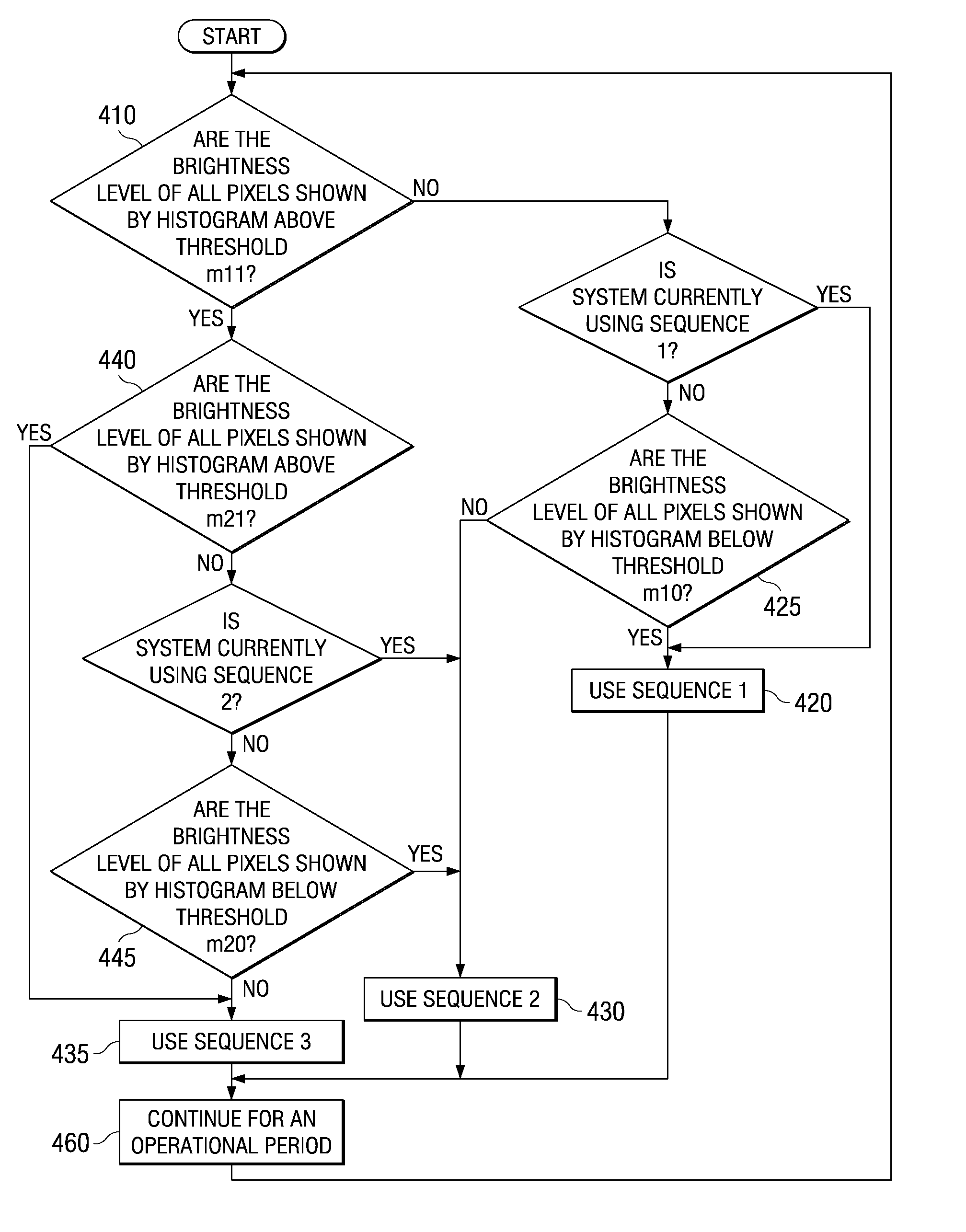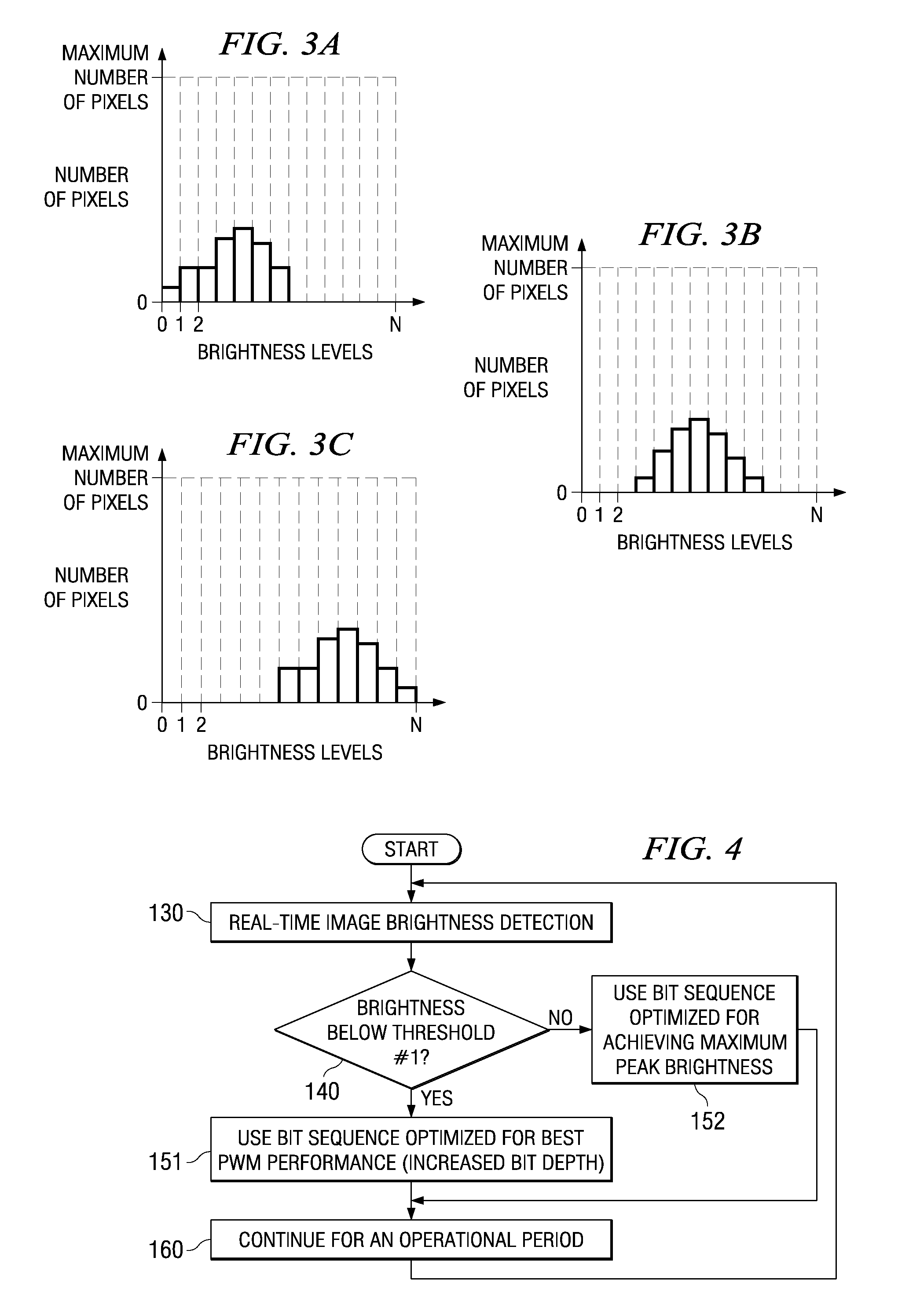[0016]There is a need for a PWM bit sequencing technique that will provide increased bit depth (allowing short bits with bit display time periods less than the
load time of the entire mirror array and / or reset blocks when needed to provide adequate detail for image discrimination) without greatly reducing the overall brightness of the display device. Disclosed embodiments address this need by dynamically selecting between a plurality of PWM bit sequences depending upon the display
image content or other image characteristics. In doing so, disclosed embodiments seek to take
advantage of the inherently limited nature of human
perception, using the limited
dynamic range of the
human eye to allow for dynamic optimization of the bit sequence.
[0017]When viewing bright scenes, the
human eye cannot distinguish between small differences in light intensity. The human eye loses the ability to discriminate between small variances of light intensity when faced with significant
background light levels (scene brightness levels above a certain threshold value). In these instances, there may be less of a need for PWM bit sequences with short bits, since the level of intensity detail discernable to the human eye is sufficiently low that short bit display intensity levels (when the bit display time period is less than the device's
load time) would be unobservable. In such bright scenes, the human eye will not generally notice if a short bit remains “on” a little too long. Any extra brightness intensity would basically be lost against the backdrop of the overall brightness of the scene. Thus, the limited
dynamic range of the human eye in perceiving brightness allows for the effective use of bit sequences without fast clears or global clears (or any type of bit with deadtime) for bright scenes.
[0018]When viewing dark scenes, however, the human eye is better able to discriminate between smaller differences in light intensity. Essentially, the contrast between the overall
darkness of the scene and the illuminated pixels may allow the human eye to discriminate between smaller differences in light intensity level. In such dark scenes, the human eye generally will notice if a short bit remains “on” a little too long, since the extra brightness would
flare out against the backdrop of the overall
darkness of the scene. So in these instances, there may be more of a need for short bits (allowing for increased bit depth and intensity resolution). By using a bit sequence that maximizes the number of short bits (utilizing fast or global clearing, for example, so that short bits with display time periods less than the device's
load time may be shown), improved bit depth and PWM performance (minimizing PWM artifacts) may be achieved when displaying dark scenes.
[0020]Similarly, scenes with the sort of significant motion that might lead to PWM artifacts might be better displayed by maximizing short bits, while scenes without significant motion may not require bit sequences with associated “deadtime.” Dynamically selecting the appropriate bit sequence for displaying a particular scene allows short bits to be available to provide increased bit depth when necessary, so that all of the image data discernable in a dark scene (or necessary to prevent PWM artifacts due to motion) may be accurately displayed, while the brightness of the device would be increased by using a bit sequence that does not create “deadtime” when displaying bright (and / or still) scenes. Disclosed embodiments might also use one or more intermediate bit sequences for scenes with brightness above the dark threshold but below the bright threshold, for example, with multiple intermediate bit sequences providing for smooth transitions.
[0021]The threshold values for selecting which bit sequence to use for displaying a particular scene might, for example, be determined based on the ability of the human eye to perceive differences in intensity levels and PWM artifacts against a particular background (scene) level of brightness. So, the appropriate bit sequence might be selected by analyzing scene brightness and comparing the brightness to the pre-determined human
perception thresholds. Alternatively, the appropriate bit sequence might be selected based on other factors, such as the amount of motion present in a given scene. Using this type of dynamic bit
sequence selection technique may allow for optimization of the PWM bit sequence based on the
observable display characteristics (such as scene brightness or motion), taking into account the practical range of discrimination of human perception. Dynamically selecting bit sequences provides for a flexible approach, allowing for selection among any of a number of it sequencing techniques, including bit sequencing techniques that include using reset blocks, global clears, or fast clears) in order to provide an optimized display having increased bit depth, increased brightness, and decreased PWM artifacts.
 Login to View More
Login to View More  Login to View More
Login to View More 


